Jude Knight's Blog, page 68
December 11, 2020
A Tale of Two Princes
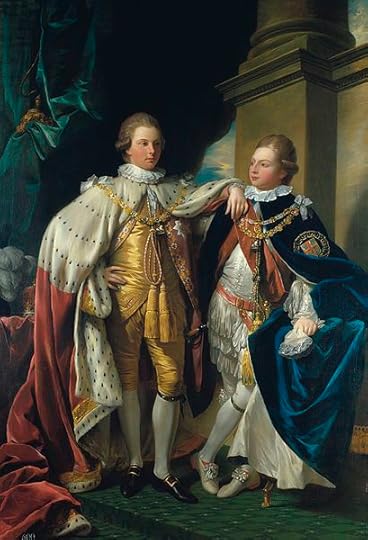
The handsome young pair above are Prince George, the Prince of Wales, and his next youngest brother, Frederick, Duke of York and Albany. They were fifteen and fourteen respectively when this was painted. Prince George was two years off his much-publicised affair with the actress Mary Robinson that marked the transition of his strained relationship with his father from sullen obedience to open rebellion, and that gave him the moniker ‘Florizel’.
Poor George was stuck with the role of Prince of Wales–fundamentally king in waiting and by all that’s holy boy, you’d better wait patiently. Frederick, on the other hand, was gazetted as an officer in the army the following year. So the age of seventeen was momentous for both of them: one set out publicly on a life of hedonism, display, emotional excesses and rebellion, and the other began a career in the army, and is credited with accomplishments that include carrying out the major reforms that fitted the army for the Peninsular campaign of the Napoleonic wars, founding Sandhurst, a military school which promoted merit-based training for future officers.
Yes, he had an expensive gambling habit, but he was also a hardworking military officer and later served in the House of Lords.
The Prince of Wales, on the other hand, had to invent his own role. Patron of the arts, pain in his father’s rear end, lover, entertainer, home renovator extraordinaire… poor George.







December 9, 2020
Beleagured heroines on WIP Wednesday
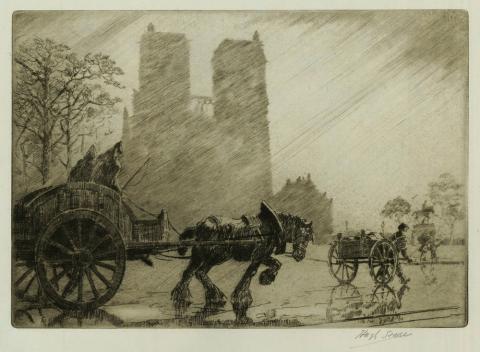
Some heroines face huge challenges, and those are my favourite sort. Do you have a WIP excerpt to share? Mine is from the beginning of my newsletter subscriber story for next week’s newsletter. (If you’d like to read the rest and don’t get my newsletter, click on the subscribe tab, above/)
The oiled cloth over the cart had thinned in places, and the persistent rain had found every crack and hole. The water insinuated itself in drips and trickles and rivers, pooling in the base of the cart until Lily was sitting in an inches-deep lake that continued to grow.
The baby was dry, at least. She’d managed to find a relatively undamaged part of the covering to sit under, wriggling until the damaged places leaked onto her back and not her chest where Petey slept, bound inside her shawl.
Lily tried to sleep, too, but between the wet and the worry, she was as wide awake as she had been when the carter picked her and Petey up hours ago. She was grateful, of course, for the ride, but each turn of the wheels took her closer to her destination and having to give Petey up.
That is, if they would take him. They wouldn’t turn away their own kin? Not at Christmas?
“They will love you, Petey,” she assured the baby. He was the dearest of infants, sweet natured and cheerful. Surely Daisy’s family would be thrilled to have him? “I will pay them for your board, or at least for a few months. Once I have a new job, I will be able to send more.”
Her one-sided conversation was interrupted when the cart stopped. Mired again? But no. The voices of the carter and another man filtered through the drumming of the rain, and then the cover was twitched back.
“We won’t reach Little Crawston tonight, Missus. We have to stop. Better get yourself and the wee ’un out of the rain.”
He helped her over the side of the cart, and set her on the ground, then gave her a push in the direction of a lighted door. “Go on inside. No going any further tonight.”
Lily hurried out of the rain. What choice did she have? But if she spent the few coins she had left on a night’s accommodation, would she have enough left to leave money with Daisy’s family? She had already paid the carter for the ride. And she needed a few coins, too, to get her to a big enough town for her to find work as a maid. No point in trying to get another governess job, not with the most recent reference she could show being three years old.







December 7, 2020
Spotlight on Dangerous Nativity
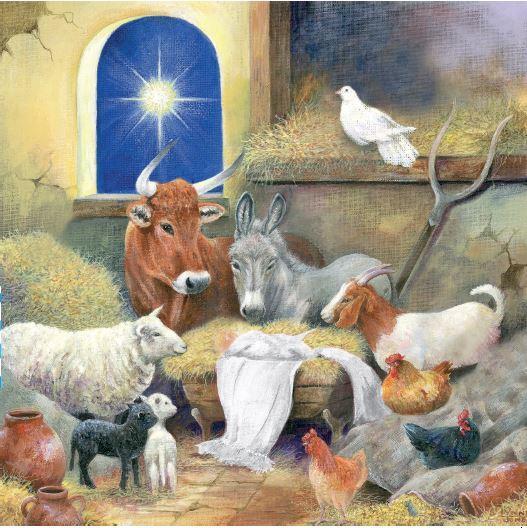
A Dangerous Nativity is high up the list of my all time favourite novellas. Meet the wonderful Will Chadbourn, Catherine Wheatley–the intriguing neighbour with the same surname as his ducal nephew, who lives on a small holding next door to his nephew’s estate, and three of Caroline Warfield’s signature children. You’ll chuckle at the nativity that Catherine’s brothers, aided by Will’s nephew, plan to stage with their farm animals. You’ll be as keen as Will to discover what lies behind the animosity between the two Wheatley families. You’ll love Will’s patience and his kindness. A Dangerous Nativity is a Do Not Miss this book. If you read no other Christmas stories this year, read this one.
It’s the fourth novella in Holiday Escapes, a collection of stories republished from the Bluestocking Belles 2015 box set, which has long been out of publication.
Read more about the box set and preorder from one of the buy links here.







December 2, 2020
Conflict in WIP Wednesday
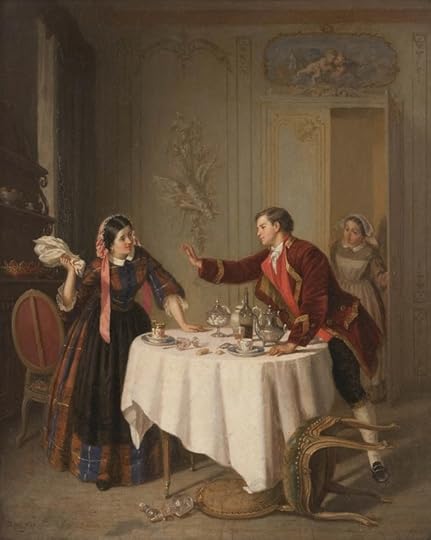
They met, fell in love, married, and never had a cross word or an angry thought from the first introduction until their death 80 years later. It would be a lovely life to live, but it isn’t my life nor that of anyone I’ve ever heard of. Conflict is part of life, and it certainly makes for more exciting stories. Conflict external to the main relationship, yes. But also conflict within the relationship. So that’s this week’s theme. I’m posting a bit from To Reclaim the Long-Lost Lover that gives the reader some strong clues about the conflict to come. Please add your own excerpt into the comments.
Sarah is choosing a husband. That thought dominated all others, and he had been escorted to the door by a footman and was out on the footpath again before he fully aware of being dismissed.
His childhood sweetheart, his first love, was still unwed but planning to choose a husband. His reaction—the sheer revulsion at the thought—had been unexpected. Yes, he had wanted to meet her again, let her know what had happened to him, make peace between them. He had even hoped to find out whether the grown Sarah and the grown Nate might be able to find some sparks of the fire that once burned when they touched.
A third of a lifetime had passed, and he had changed. He must assume she had, too. Perhaps they would meet and dislike one another, or meet and agree to part as friends. But his immediate reaction when Lady Charlotte mentioned that damnable list was to claim his long-lost love as his own.
Nate had walked seven blocks and had passed the street he was meant to turn down. He backtracked to the missed corner. Nothing had changed and everything had changed. He still could not move on with his own life until he knew whether the unbroken connection between him and Sarah Winderfield was all on his side, or whether she felt it too. But now he knew that the clock was ticking.
He needed to meet Sarah, clear up her misconceptions about his disappearance, find out if he still wanted the role that had once been his greatest ambition, and convince her to love him again. And all before she chose another husband.
A thought occurred and stopped him short. She had a short-list. He wasn’t, then, competing against a love match. He stepped out towards his father’s townhouse, a smile spreading as he considered that fact. He’d put the next two weeks to good use, using Libby and her contacts to find out who was courting Lady Sarah, who she favoured, and what they were like. The clubs, too. He’d buy horses and play cards—whatever it took to be accepted into the conversation men had when women were not around. By the time he saw her again, he’d be armed for the battle ahead. He’d know what she looked for in a husband, and also what was wrong with the suitors she was considering.







November 29, 2020
Tea with Henry

Eleanor poured Lord Henry another cup of tea. With the continuing war, he seldom had time away from the Horse Guard to spare an hour for an old friend of his dear deceased wife, and she was enjoying catching up on news of Susana’s children. Eleanor often saw her goddaughter, Susan, now married to a naval officer, and with small children. But the boys had all followed their father’s footsteps and were overseas with the army, or their maternal grandfathers, into the navy. Harry and Alex, the soldiers, were on foreign soil fighting for King and country, and Jules, the youngest, was doing the same far away on the other side of the world with the navy.
Rick was Henry’s main concern today. Invalided home, he had undergone painful medical treatment to be able to walk again, and had recently left town, much to his father’s and sister’s dismay. “He is going to Portsmouth, where he thinks the naval doctors may be able to get him back to full health more quickly,” Lord Henry said. “I wish he hadn’t chosen to ride, Eleanor. He says he will stop early and often, but I worry. We thought we would lose him, you know.”
“Yes, Susan told me. She has been very anxious about him.”
Lord Henry sighed. “That is part of the problem. My dear daughter has been hovering over him constantly, and I believe he has run away from her care as much as to his naval doctors.”
“It is hard not to fuss when those you love are in pain,” Eleanor commented.
“I can only hope he finds what he needs, and not trouble,” the concerned father said.
***
Rick Redepenning finds trouble and what he needs in the form of his former admiral’s daughter, in Gingerbread Bride, now available as part of the anthology Holiday Escapes.







November 26, 2020
Cravats, Kerchiefs, and Neck Ties
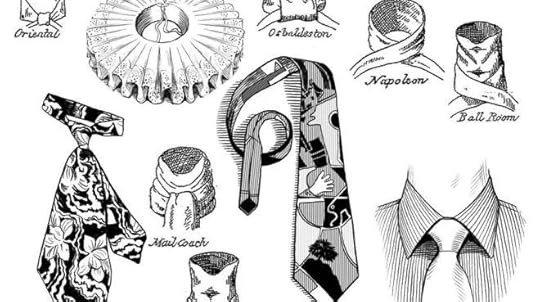
One of the great benefits of leaving his last office job, according to my personal romantic hero, was that he could get rid of most of his neckties. Ghastly things, he reckons, with no practical purpose. He kept a couple for formal occasions, and the rest went to the charity shop, to torture some other poor fellow.
I was thinking about that the other day, as a friend and I looked at a period inappropriate book cover. According to the artist, the male model was Victorian, but that’s a period of more than six decades. Men’s neckwear changed in that time, so I went looking to find out how and when.
First, let me take you back to the beginning. Neck scarves of some kind were worn in ancient times. We can see them in the Terracotta Warriors, in Roman soldiers on Trajan’s Column, and in pictures of medieval knights and Mongol warriors. A likely purpose was as a practical garment to tuck round the edge of armour to stop chafing, or to perhaps to stop sweat from rolling down the neck and setting up an itch, or to keep the neck warm, or even for multiple purposes, not the least of which might be battlefield medicine.
Their evolution from a practical garment to sartorial elegance dates back to the Thirty Years War. This was a conflict fought in Europe in the first half of the seventeenth century, as part of the struggle for dominance between the Austro-Spanish Hapsburgs and the French Bourbons. The French hired mercenaries from Croatia, and they wore a neck scarf to tie the top of their tunics shut. The look caught on among the French and spread from there. Of course, the aristocrats who adopted the fashion wore lace cravats (La Cravatte was the name given to the neckwear by Louis XIII; a nod to the Croatians).
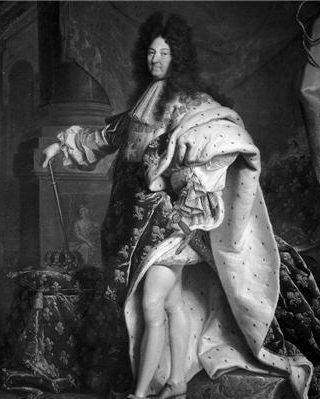 The lace got steadily more extravagant through the early part of the eighteenth century, and matched with lace cuffs made a spectacular show.
The lace got steadily more extravagant through the early part of the eighteenth century, and matched with lace cuffs made a spectacular show.
Then came the French Revolution, which affected fashion as well as politics. The revolutionaries affected a less ostentatious style of dress, and — in fashion — where the French led, the rest of Europe followed. The cravat we know from Regency movies and books was born. The cravat covered all but the collar of the shirt, and often that, as well — a shirt being regarded as underclothes at the time. A long rectangle of fabric was folded and intricately knotted to the specifications of the wearer (or his valet, but a gentleman with pretensions to elegance would not trust such an important detail to his valet).
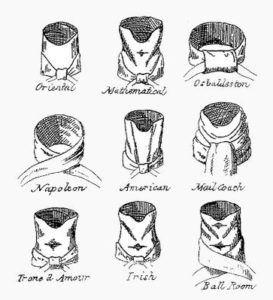
At the turn of the century, Beau Brummell dictated that the cravat should be a crisp white as should the stockings, the breeches and coat black, and only the waistcoat in colour. Of course, not everyone agreed, and cravats of all colours can be seen in paintings of the time.
The simplest and most casual way of tying a cravat was to wrap it around the neck several times and tie a bow, and this became highly fashionable as the nineteenth century wore on. By the 1850s, gentlemen were wearing a black cravat or bow tie, simply folded and pinned so that the shirt showed between the bottom of the tie and the top of the waistcoat. A thinner piece of material became the Ascot tie, so called because it was casual wear for events such as race meetings–recognisably a necktie like those still worn today, but much wider, and pinned to the shirt.
The next evolution was the club tie, purportedly created in the 1880s, when the rowing team of Exeter College, Oxford, took the striped bands off their hats and tied them around their necks.
The modern necktie was invented by an American in the 1920s — three pieces of material cut on the bias, thus eliminating wrinkles. My husband’s least favourite item of men’s clothing had arrived.







November 25, 2020
Loyal servants or friends on WIP Wednesday
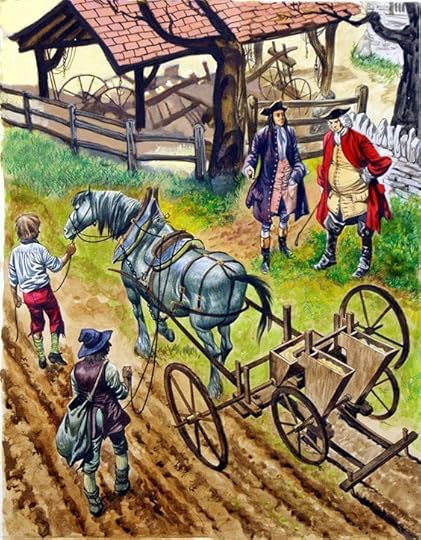
We come to know our characters by the way they behave with those around them. Here’s my hero Val with his valet/butler and his senior tenant. Please feel free to share a work-in-progress excerpt of your own in the comments.
Val heard Crick before he saw him. “My lord, my lord,” the man was shouting, his voice high with barely suppressed panic. Val excused himself from a discussion about clearing a blockage in a stream that was threatening to flood the young barley, and took a few paces to meet Crick as the butler came hurtling across the field, careless of the new shoots.
“My lord, we’re under attack. They’ve captured the house, my lord.”
Val took the man’s arm and led him to the side of the field. “Take a deep breath, Crick,” he soothed. “All is well. We are in England. For us, the war is over.”
Crick pulled his arm free and so far forgot himself as to seize Val’s shoulders. “No, sir, you don’t understand. Soldiers on horseback. A lady with a sword. Another lady in the carriage. I tried to stop them, sir, but they forced their way into the house. They made Mrs Minnich take them to the family wing. We have to marshal the tenants, my lord, and rescue the servants.”
Being addressed as ‘my lord’ gave Val pause. Usually, when Crick had one of his episodes, he reverted to Val’s former rank. Always, in fact. When Crick called Val ‘major’, the whole household knew to hide anything that could be used as a weapon.
Barrow and his gangly young son had followed and were listening. Val met Barrow’s concerned eyes. “A carriage and some horsemen went down the lane a while back,” Barrow disclosed. The lane was out of sight from here, but Barrow explained his knowledge by fetching his son a clip across the ear. “The boy here saw them when he went to fetch the axe, but didn’t say nothin’”
Young Barrow’s observation suggested some truth to Crick’s fantasy, but it couldn’t possibly be the invasion Crick imagined. What would be the point? “I’ll investigate,” Val decided.
Crick and Barrow protested him going alone. “Five men, my lord,” Crick insisted. “Foreigners, they were, and the lady, too.”
Val’s troops were a half-mad butler, plus a burly tenant farmer, and his fifteen-year-old son. Val would do better alone. “You shall be my back-up,” he told them. “Stay at the edge of the woods where you can see the house. If I don’t come out within thirty minutes and signal that everything is safe, ride to the village for help.”
Crick argued, but Val was adamant. Still, as he crossed the open ground to the house, his skin prickled with the old familiar sense of walking into enemy territory.







November 22, 2020
Gingerbread Bride on Spotlight on Sunday
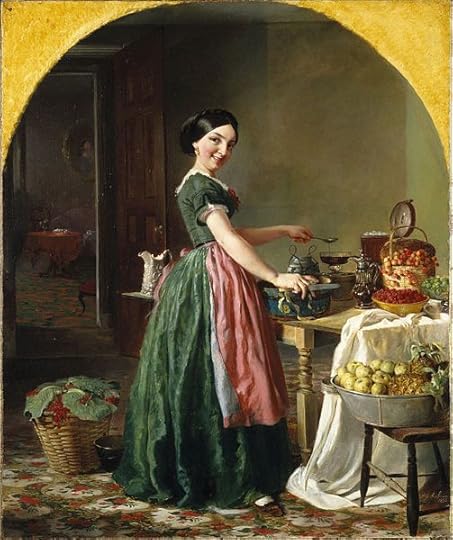
After sailing the seven seas with the King’s navy for most of her life, admiral’s daughter Mary finds London hard to take, and her grasping aunt and nasty cousin even worse. A trip to find other relatives to live with brings dangers aplenty, but also Rick the Rogue, once a midshipman on her father’s ship, riding once more to her rescue.
The plot includes brides made out of gingerbread, runaway carriages, a pair of wicked cousins who almost deserve one another, a chaotic household in the midst of Christmas preparations, and one of the sweetest proposals I’ve ever written. It is the first story (chronologically) in the Golden Redepennings sage.
Gingerbread Bride is the third novella in Holiday Escapes, a collection of stories republished from the Bluestocking Belles 2015 box set, which has long been out of publication.
Read more about the box set and preorder from one of the buy links here.







November 20, 2020
The farmhouse that grew

Once upon a time there was a prince who liked to go to the seaside. One of his favourite uncles lived in Brighton, and George found the seaside resort very much to his taste. He rented a rather pleasant farmhouse, Brighton House, from a member of his staff, and later entered into a lease that let him make the changes he wanted.
The architect he chose, Henry Holland, built a rotunda over the grand dining room, and added a new wing. Brighton House became Marine Pavilion.

But it didn’t stop there. Next came extensive stables, with room for 60 horses. The stables were even bigger than the house.
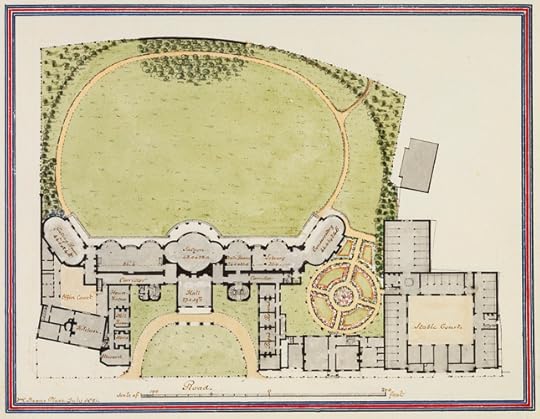
But soon, that wasn’t enough. I guess the prince was having fun. The interiors were originally neoclassical, but the prince was soon having them all converted to the new oriental style, and then he had some even grander ideas. The original architect built on again, adding more rooms, but that still wasn’t enough. By 1815, a new architect, John Nash, was working on the building we have today–little is left of the first two incarnations of the building, apart from the room under one of the new domes, once the dining room, then the grand saloon.
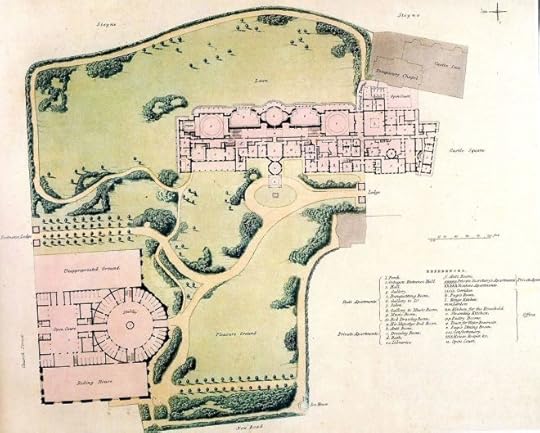
The building was finally finished in 1823, and by then our prince was king, and too busy for more than two more visits to the farmhouse that grew.
***
I was looking into this because I had my heroine in my latest book visit the Royal Pavilion, and I suddenly thought to check whether it had been built yet. It hadn’t. It was still the Marine Pavilion.







November 18, 2020
Again with the first meetings on WIP Wednesday
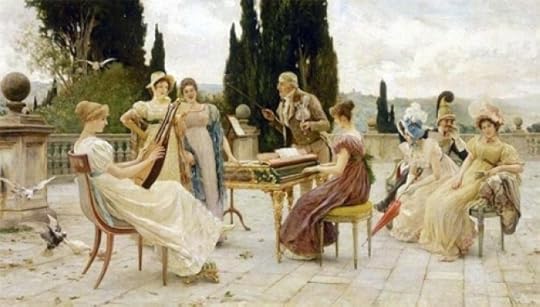
I gave you Nate’s impressions of his love eight years after he last saw her, so I thought I’d give you the next scene. By all means, feel free to share one of your meetings in the comments.
It was Nate. Sadie kept assuring herself that she must be wrong. He had changed so much from the slim boy she had once loved. She smiled and nodded, allowed Lord Hythe to escort her around the room, made cheerful nonconsequential comments. And all the time, she was conscious of the man, watching him out of the corner of her eye, wondering what it was about him that screamed his identity.
He was a lot taller and broader; that was to be expected. He had been shooting up like a weed when she knew him, but had not yet reached his adult size. His face had squared off. Once, he had been a beautiful youth—a dark-haired Ganymede, her brother called him, with a smirk she didn’t understand until her Aunt Georgie explained that the Trojan prince had been stolen by Zeus who desired him because of his beauty.
Poseidon would fit him better than Ganymede, now. Strength, barely-leashed power, serious and forbidding, except when he smiled at the woman with him. Who was she? His wife? They knew one another well, staying within reach of one another as they moved around the room.
He was breathtaking when stern. The smile transformed him. Even the scar that crossed one cheek in a ragged line added to his beauty; a contrast to perfection.
The eyes were the same, she decided. The same colour and shape, at least, though the cynicism with which he regarded the company was new.
Before they had reached the group that included Sadie, Hamner’s butler called dinner, and Lady Hamner began pairing people off to go to the dining table. Nate, Sadie noticed, was paired with another lady, and the one he had arrived with happily accepted the escort of one of the lords Sadie had on her list.
Lola guided her own dinner partner over to Sadie, and asked, out of the corner of her mouth, “What is the matter?” Her twin might not know what was wrong, but she always knew how Sadie felt.
“No time. Can we go straight home after dinner?” Sadie whispered back. The line passed through the doorway, and the sisters had to peel off in different directions, but Lola would make their excuses when the time came. Sadie couldn’t face Nate until she had time to absorb the fact of his return.










